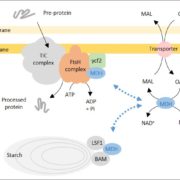
Nuclear Positioning Requires a Tug-of-War Between Kinesin Motors
Blog, The Plant Cell, The Plant Cell: In BriefThe microtubule (MT) cytoskeleton is a dynamic network of self-assembling highways that, together with the help of motor proteins, promotes intracellular transport and the formation of magnificent structures such as the preprophase band, mitotic spindle, and phragmoplast (Nebenführ and Dixit, 2018). …

Moonlighting NAD+ Malate Dehydrogenase is Essential for Chloroplast Biogenesis
The Plant Cell, The Plant Cell: In BriefSome proteins are put to work in more than one job, in a form of evolutionary improvization. They are often described as "moonlighting" proteins, referring to the practice of people taking a second job, typically after dark, to help pay the bills. A classic example of a moonlighting protein is the…

Alternative Splicing Plays a Major Role in Plant Response to Cold Temperatures
The Plant Cell, The Plant Cell: In BriefPlants in temperate regions experience near-freezing temperatures that allow them to develop a cold response prior to freezing. This cold acclimation process involves changes to chromatin structure, transcription, RNA processing, translation, post-translational modifications and protein stability. Genome-wide…

Regulatory Divergence in the Stress Response of Tomato
The Plant Cell, The Plant Cell: In BriefHumans have domesticated crops for thousand of years by artificially selecting plants for numerous traits including morphology, lower toxicity or higher yield. As a result, plant domestication often altered plant fitness and resistance to stress under controlled conditions (Meyer & Purugganan 2013).…

Nitrate Ahoy! Shoot Cytokinin Signals Integrate Growth Responses with Nitrogen Availability
The Plant Cell, The Plant Cell: In BriefNutrients are rarely distributed homogenously in soil. Consequently, plants have local and long-distance signaling systems in place to monitor and coordinate both demand and supply of essential macronutrients such as nitrogen (N). The “N-demand” long distance signal emanates from a section of the…

Is Genetic Evolution Predictable?
The Plant Cell, The Plant Cell: In BriefHow often does evolution repeat itself? When the same evolutionary strategy arises multiple times, how often are these strategies built on the same genetic foundations? Addressing this question allows us to understand the relative roles of constraint and contingency in the history of life, but (without…

Live and Let Die: Phosphatidic Acid Modulates the Self-Incompatibility Response
Research, The Plant Cell, The Plant Cell: In BriefPollen tubes are remarkable vehicles that deliver immobile sperm nuclei from the stigma to the ovule during angiosperm reproduction. Their journey delicately balances turgor pressure with the precise spatiotemporal regulation of polarized growth machinery to navigate pollen tubes and their cargo to the…

Life of PPi: Soluble PPases and H+-PPase act cooperatively to keep pyrophosphate levels in check
Blog, Research, The Plant Cell, The Plant Cell: In BriefInorganic phosphate (PPi) is a byproduct of many metabolic reactions, including those involved in sucrose, sugar nucleotide, and cellulose biosynthesis. Although PPi is an important phosphate donor and source of cellular energy, high levels of cytosolic PPi are toxic, disrupting the metabolic reactions…

A Tale of Three Studies: Uncovering the Crucial Roles of m6A Readers
Blog, Research, The Plant Cell, The Plant Cell: In BriefThe story behind m6A (methylation of the N6 position of adenosine), the most common internal mRNA modification in eukaryotes, has long been a source of intrigue. This epitranscriptomic mark is deposited at specific mRNA sequences by m6A writers and removed by m6A erasers. The m6A marks recruit and anchor…

